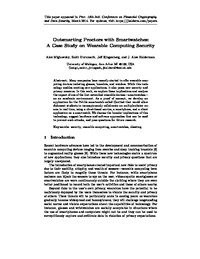 Diese Seite wurde seit 10 Jahren inhaltlich nicht mehr aktualisiert.
Unter Umständen ist sie nicht mehr aktuell.
Diese Seite wurde seit 10 Jahren inhaltlich nicht mehr aktualisiert.
Unter Umständen ist sie nicht mehr aktuell.
 Zusammenfassungen
Zusammenfassungen
Many companies have recently started to offer wearable computing
devices including glasses, bracelets, and watches. While this technology
enables exciting new applications, it also poses new security and
privacy concerns. In this work, we explore these implications and analyze
the impact of one of the first networked wearable devices—smartwatches—
on an academic environment. As a proof of concept, we develop an
application for the Pebble smartwatch called ConTest that would allow
dishonest students to inconspicuously collaborate on multiple-choice exams
in real time, using a cloud-based service, a smartphone, and a client
application on a smartwatch. We discuss the broader implications of this
technology, suggest hardware and software approaches that can be used
to prevent such attacks, and pose questions for future research.
Von Alex Migicovsky, Zakir Durumeric, Jeff Ringenberg, J. Alex Halderman im Text Outsmarting Proctors with Smartwatches (2014)  Dieses Konferenz-Paper erwähnt ...
Dieses Konferenz-Paper erwähnt ...
 Begriffe KB IB clear |  Hardware Hardware hardware
, IT-Sicherheit
, pebble watchpebble watch
, hardware
, IT-Sicherheit
, pebble watchpebble watch
,  Privatsphäre Privatsphäre privacy
, privacy
,  Prüfung
, Prüfung
,  Sicherheit Sicherheit security
, security
,  Smartwatch Smartwatch smartwatch
, Wearable ComputingWearable Computing smartwatch
, Wearable ComputingWearable Computing
|
 Tagcloud
Tagcloud
 Volltext dieses Dokuments
Volltext dieses Dokuments
 |  Outsmarting Proctors with Smartwatches: Artikel als Volltext ( Outsmarting Proctors with Smartwatches: Artikel als Volltext ( : :  , 836 kByte; , 836 kByte;  : :  2021-03-21) 2021-03-21) |
 Anderswo suchen
Anderswo suchen 
 Beat und dieses Konferenz-Paper
Beat und dieses Konferenz-Paper
Beat hat Dieses Konferenz-Paper während seiner Zeit am Institut für Medien und Schule (IMS) ins Biblionetz aufgenommen. Er hat Dieses Konferenz-Paper einmalig erfasst und bisher nicht mehr bearbeitet. Beat besitzt kein physisches, aber ein digitales Exemplar. Eine digitale Version ist auf dem Internet verfügbar (s.o.). Aufgrund der wenigen Einträge im Biblionetz scheint er es nicht wirklich gelesen zu haben. Es gibt bisher auch nur wenige Objekte im Biblionetz, die dieses Werk zitieren.










 Biblionetz-History
Biblionetz-History